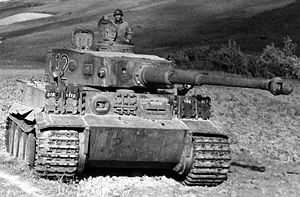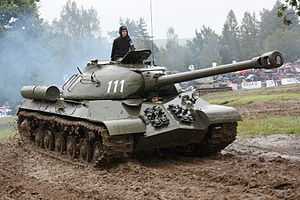Heavy tank
| Heavy tank | |
|---|---|
|
Soviet IS-3 heavy tank | |
| Type | Tank |
| Service history | |
| In service | 1917 – ca. 1990s |
| ||||||||||
A heavy tank was a subset of tank that provided equal or greater firepower as well as armor than tanks of lighter classes, at the cost of mobility and maneuverability and, particularly, expense.
Heavy tanks have usually been deployed to break through enemy lines, though in practice have been more useful in the defensive role than in the attack. Design goals have included attacking obstacles, creating breakthroughs, and engaging enemy armoured formations.
Line between heavy and medium tanks
There was not a consistent line distinguishing heavy and medium tanks. The line was drawn by each country's army according to its needs; very frequently the threshold was based on the weight sustainable by the country's most common bridges or by railroad loading limits.[note 1]
Role
Heavy tanks achieved their greatest successes both fighting other, lighter tanks, and destroying fortifications with their very large guns. Although it is often assumed that heavy tanks suffered inferior mobility to mediums, this was not always the case, as many of the more sophisticated heavy tank designs featured advanced suspension and transmission precisely to counteract this drawback. But the greatest drawback is cost which translates into production, resulting in short supplies. The German Tiger I, for example, had similar speed and better terrain-handling characteristics when compared to the significantly lighter Panzer IV medium tank, albeit at the cost of low reliability and only 1,355 were produced compared to 8,800 Panzer IV and 58,000 Soviet T-34 and 40,000 American M4 Sherman medium tanks.
Design
Heavy tanks feature very heavy armour and weapons relative to lighter tanks. Many heavy tanks were based on lighter tanks or shared components from them; for instance, the American M103 shared many components with the lighter Patton tanks including its transmission and engine. As a result they tend to be either underpowered and comparatively slow, or have engine and drive train reliability problems. Heavy tanks tend to have excellent protection compared to their lighter cousins.
History
The heavy tank concept originated in World War I and coexisted with light and medium tanks until the end of the Cold War with the introduction of the main battle tank.
World Wars

The first British tank, the Mark I of World War I, was introduced to break through the German defensive lines of trenches and barbed wire. When a lighter faster tank was introduced this was designated "Medium Mark A" (and known as Whippet) and the larger tanks known as "heavies".
The Char 2C was one of the largest tanks ever produced. At the start of World War II, the French and the Soviets were the only countries to have inventories of heavy tanks, such as the Char B1, T-35, and KV-1. The Matilda II infantry tank, though not weighing as much as the others, was designed to the British infantry tank concept and had thicker armour than most tanks in service at the time. Later war examples were the German Tiger I and II, as well as the Soviet IS series. Note that "heavy" versus "medium" is more a question of tactical roles than weight; the Panther, for example, was a "medium" tank that outweighed most Allied "heavy" tanks.
American forces rarely fielded heavy tanks, preferring to use tank destroyers for anti-tank combat, and their Sherman medium tanks were outclassed in terms of armor and weapons by most heavy tanks.
Cold War

The immediate post-war period saw the final fielding of heavy tanks, including the US M103 heavy tank, the British FV214 Conqueror, and the French ARL 44, all in response to the Soviet heavy tanks of the period. The largest tank guns were approaching maximum calibre whose shell could still be handled by the crew, even using awkward two-part ammunition (separate projectile and propellant case), which greatly slowed their rate of fire. Thanks to improved gun designs and fire control technology, postwar medium tanks were catching up to heavy tanks in firepower. The tactical value of heavy tanks thus declined to the point that no new designs were fielded; the heavily armed mediums came to be known as the main battle tank (MBT). Doctrine held that less expensive self-propelled artillery could serve in the infantry support role. The weight of MBTs quickly increased during the Cold War, and most third generation MBTs including the M1 Abrams, Challenger 2, Leopard 2, Merkava, Arjun MBT, and Type 99 have weights similar to those of 1950s heavy tanks.
Older heavy tanks with steel armour were rendered obsolete by anti-tank guided missiles and high explosive anti-tank (HEAT) ammunition. The much more flexible missiles are effective at ranges beyond a tank gun's range, and sheer armour mass was no longer a guarantee of survivability against the largest HEAT warheads of tank guns or missiles.
See also
Notes
- ↑ The railroad was usually the preferred method of movement of the armored units; the vehicle tracks were saved for the times of absolute necessity.
References
| ||||||||||||||||||||||||||||||||||||||
| ||||||||||||||||||||||||||||||||||
| ||||||||||||||||||||||||||||||
| ||||||||||||||||||||||||||||||||||||||||||||||||||
